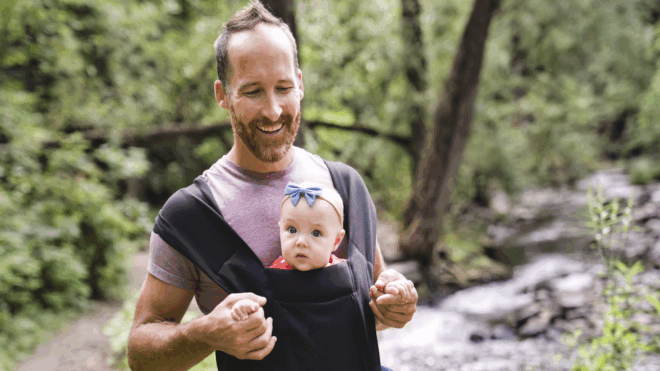
In this article
Since asymptomatic carriers of COVID-19 can still infect people, the Centers for Disease Control and Prevention advises using simple cloth face coverings to slow the spread of the virus — especially when in public settings that are difficult to maintain proper social distance, such as pharmacies and grocery stores. Some states require the wearing of face masks in public, and experts are calling on all states to mandate masks or face coverings of some kind.
While you can buy cloth ones (sometimes from your favorite stores), you can also make face masks at home instead of buying disposable masks — this keeps medical masks available for the more vulnerable. Here are some tips for making your own face masks — and why they are so important to protect yourself and those around you.
The importance of wearing masks

As pediatrician Dr. Steph Lee informed Mom.com, “Social distancing is important to protect yourself from getting the virus and protect yourself from spreading it to others. People can be infected with the new coronavirus but be lucky enough not to show symptoms,” explained the spokesperson for the American Academy of Pediatrics. “However, they can still spread the virus to others.” This is where the importance of masks comes in.
There are two main reasons for wearing masks: to protect yourself from others or to protect others from you. To protect yourself, you will need a medical-grade respirator mask, correct fit, and to be careful when taking the mask on and off. In general, reserve these medical-grade masks for those workers on the front lines of the pandemic.
As for protecting others, wearing even a cotton mask is a relatively simple way to slow down public transmission. Research has shown that cotton masks can reduce the virus particles emitted from our mouths by as much as 99%.
How to make a face mask at home

If you have access to a sewing machine, here is one way you can make a face mask at home. Note: These instructions are for both with and without a filter. To add a pocket for a filter, check out the optional instructions in Steps 2 and 5.
Materials needed
- Sewing machine
- Needle and thread or bobby pin
- Scissors
- Two 10-inch by 6-inch rectangles of cotton fabric
- Two 6-inch pieces of elastic, string, cloth strips, rubber bands, or hair ties
- Optional: Purchased filters (e.g. HEPA filters cut to fit)
Instructions
1. Using tightly woven cotton (e.g. quilting fabric or cotton sheets or T-shirt fabric), cut out two 10-inch by 6-inch rectangles. Stack the two rectangles and sew them together as if it were a single piece of fabric.
2. Fold the long sides over 1/4 inch and hem. Then fold over the now double layer of fabric 1/2 inch along the short sides and stitch down.
Option: To create a pocket for a filter, separately hem the long sides on the top part of the mask before you fold the short sides and stitch down.)
3. Using a large needle or bobby pin, thread 6 inches of 1/8-inch wide elastic (or string, cloth strips, rubber bands, or hair ties) through the wider hem on each side of the mask for ear loops. Tie the ends tight. If using string or strips, make them long enough to tie behind your head.
4. Pull the elastic so the knots are hidden within the hem. Try the mask on your face and adjust the sides around the elastic so it fits correctly. Once you’re happy with the fit, stitch the elastic in place to stop it from slipping.
5. If you are adding a filter, cut the filter material to size and fit into the pocket.
For other options, Aaronica Bell Cole has an easy tutorial for an accordion-style mask. She suggested adding an extra layer of protection by inserting HEPA filters.
You can also make small changes to better fit your preferences. Mom of three Dre Siu told us, “I followed the instructions on the Kaiser website for donation masks and replaced the ties with elastic.”
“I like this pattern by Tiana’s Closet the best because it fits snug against the face but there is more space around nose and mouth so breathing is a little easier,” mom of two Sandy Cao shared with Mom.com. “I added a filter pocket and nose piece to it.”
Best fabrics and other tips

Mom Tomika Bryant recommends cotton blends for the outer later and broadcloth for the inner layer, as her friend Scherrie Donaldson uses in the masks she makes and sells. “The corded elastic works better for around the ears and the flatter elastic is good for around the head,” Tomika added.
For a better fit, you can also try pipe cleaners or the twist ties that come with electronics to make a nose wire. “Having a wire to fold over the bridge of the nose makes for easier wear for long days when you are talking since it helps to hold it in place,” teacher Sandi Lawver Francioch explained to Mom.com.
If you’re making masks in bulk, mom of three Emily Lai recommended a couple of tools to expedite the process. “Invest some time to make yourself a pleater board and bias tape maker,” she told Mom.com. “You can DIY from cardstock and do a search on YouTube.”
Natasha C. Nicholes, who has churned out hundreds of masks for her local community and friends, suggested a time-saving tip. “Chain stitch the masks in groups of 10, and then work the assembly line out of all pieces! It beats completing them one at a time.”







